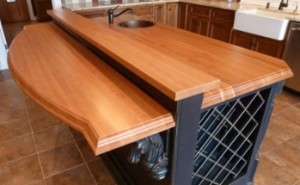 Where do your party guests end up? For me, the answer is the same every time… gathered in the kitchen. And as the food and drinks flow, so does the conversation. I love that my kitchen is a warm and inviting place to gather.
Where do your party guests end up? For me, the answer is the same every time… gathered in the kitchen. And as the food and drinks flow, so does the conversation. I love that my kitchen is a warm and inviting place to gather.
A great way to give your kitchen a warm feel is by incorporating wood countertops into your design. I spoke with Jud Dinsmore at the Southside Woodshop in Chesapeake, VA for some expert advice.
Interview with an expert
CV: How does the care and maintenance of wood countertops vary from what people typically do with granite or laminate countertops?
JD: It will vary significantly by what type of finish is applied and how the countertop is used. For those that plan on cutting directly on their countertop (using it like a cutting board), the only real choice is food safe mineral oil. This product offers little protection from water and foods that can stain, and must be maintained monthly with a refresher coat of oil. The reoiling is a very simple, wipe-on, wipe-off process that is easily accomplished in a matter of minutes, however, some homeowners see all maintenance as bad and have no interested in performing this task.
Our other option is our permanent finish. It is completely waterproof, resistant to household chemicals and foods that can stain, has been specifically engineered to resist scratches, and requires zero maintenance. Simply clean up with warm, soapy water. The only drawback is that you cannot cut directly on it.
CV: How does the price compare to top counter choices like granite?
JD: Pricing can vary significantly depending on the details. Most domestic wood species run $80-$110/sf while some exotic woods (zebrawood, teak, and wenge, to name a few) can cost more than $200/sf. Another factor that can increase the cost is to increase the thickness beyond our 1.5” standard. One of the beauties in working with wood is that there are so many options (construction style, thickness, inlays, etc) at your disposal when creating a one-of-a-kind countertop.
CV: What is the type of wood you most commonly use?
JD: Black walnut the most. Most of our builds are island countertops on painted cabinetry so an affordable, dark wood is a popular choice (dark countertop on lighter cabinets – an easy, attractive color combination). Sapele mahogany is our second most popular request and our (most guys in the shop) favorite. It is naturally a medium brown with hints of red. The wood also has iridescent properties so the grain appears to “move” as you change your viewing angle.
CV: How do you recommend a client achieve a rustic look?
JD: Hickory is seen as rustic and recommended when a client mentions this.
CV: Contemporary?
JD: Zebrawood and wenge fit contemporary as they are exotic and speak volumes when positioned to headline a room.
CV: Formal?
JD: Formal requests are typically stain or custom-matched stain jobs where the client wants a certain color or more color consistency in their countertop.
CV: Outdoor Kitchen?
JD: Most clients only know of teak’s reputation as rot and bug-resistant, great attributes for an exterior project but a non-issue for a residential kitchen.
CV: What does a wood counter add to a design project that other materials do not provide?
JD: A wood countertop and differently colored/styled island cabinets bring emphasis to this space and provide warmth and invitation that the granite/marble/solid surface on the perimeter cabinets will never offer. The warmth and organic feel of wood is what sets it apart from other popular countertop options.
Thanks for the info, Jud! We appreciate your time answering our questions and we love to see someone taking such pride in their craft!
You can learn about Jud, Southside Woodshop, and all of their exceptional products on his blog and website, found here.
**Image credit: www.customwoodcountertops.com

Recent Comments